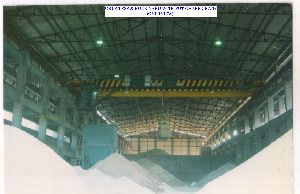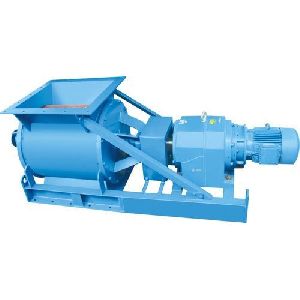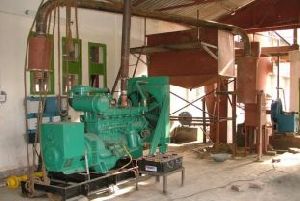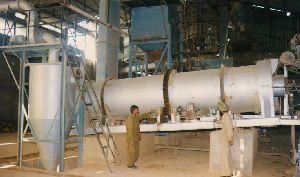
Wet Ball Mill
A ball mill consists of a hollow cylindrical shell rotating about its axis. The axis of the shell may be either horizontal or at a small angle to the horizontal. It is partially filled with balls. The grinding media are the balls, which may be made of steel (chrome steel), stainless steel, ceramic, or rubber. The inner surface of the cylindrical shell is usually lined with an abrasion-resistant material such as manganese steel or rubber lining. Less wear takes place in rubber lined mills. The length of the mill is approximately equal to its diameter. The general idea behind the ball mill is an ancient one, but it was not until the industrial revolution and the invention of steam power that an effective ball milling machine could be built. Advantages of the ball mill Ceramic ball mill before 1945 Thiem&Towe Halle. Property of Faculty of Chemistry, Gdańsk University of Technology Ball milling boasts several advantages over other systems: the cost of installation and grinding medium is low; the capacity and fineness can be adjusted by adjusting the diameter of the ball; it is suitable for both batch and continuous operation, similarly it is suitable for open as well as closed circuit grinding and is applicable for materials of all degrees of hardness.
...more
vertical kiln
Vertical kilns have among others the advantage of low investment profile and hence very suitable for small and medium scale processing of various solid minerals such as limestone. The low investment profile therefore makes it attractive in developing countries where sources of investment capital are lean. Vertical lime kilns however are plagued with a number of operational problems such as channeling, stratification, hanging accident, poor heat distribution among others. This work investigated the effects of burner types, firing rate and degree of draft on the vertical lime kiln temperature profile and hence the efficiency of the kiln. A pilot twin shaft lime kiln of 1.5 ton per day capacity was employed in the evaluation. It was shown that low firing rates of the burners affects negatively the kiln throughput and very low drafts lead to excessive backfiring of the burners. Many strategies were proposed to mitigate various negative phenomena experienced in the operations of vertical kilns. The vertical lime kilns have been shown to posses a lot of potentials in the lime industry and small scale cement industries. In view of the need to set up more small/medium scale chemical plans to meet with the local needs of chemical products like lime, the vertical lime kilns offers a good investment options. This is because of the following over-riding advantages shaft kilns posses over the rotary kilns. Low initial capital investment Low cost of operation Good flexibility of operations Low environmental pollution effects Also the vertical shaft kilns because of its labor intensive nature is appropriate for developing countries where labor is cheap and unemployment rate is very high. This work therefore seek to establish important strategies for operations of fired vertical lime kilns in order to achieve efficient operations which will ultimately encourage investments in vertical shaft kiln facilities. This is hoped will create multiplier effects that will catalyze growth of developing economies.
...more
Thermal Application
The Gasifier is a Producer Gas Plant which produces gas by Biomass(Wood/Municipal waste/Briquettes/) Coal, Charcoal which is us in so many thermal applications like Furnaces of Rolling Mills, Hot Air Drying, Textile Drying, Backing, Chemical Drying, Spray drying, Fertilizers plants, drying units etc. Producer Gas is a low pressure & high volume gas that combusted for thermal application and for low cost power generation. We can produce a temp. up to 1400°C & by using Produce Gas we are in a position to save up to 40- 45% cost as compare to fuel. WHAT IS GASIFICATION? Gasification is a process that converts municipal or industrial waste, Coal or Biomass based carbonaceous materials into carbon monoxide, Methane hydrogen and carbon dioxide. This is achieved by reacting the material at high temperatures without combustion, with a controlled amount of oxygen and/or steam. The resulting gas mixture is called syngas (synthesis gas) or producer gas and is itself a fuel. The power derived from gasification and combustion of the resultant gas is considered to be a source of renewable energy if the gasified compounds were obtained from biomass. Using Gasification Technologies in Industries Known to all, the thermal treatment in industries and manufacturing units can be done by using furnace oil or any type of fuel. However, the rising fuel price has left industries in panic situation. Due to current situation Retools India come up with an inexpensive alternative solution – The Multi Fuel Gasification Technologies. When we discuss about most of Industries Thermal application is the major step that consumes huge amount of furnace oil having huge cost. Now days some Industries are using coal pulverizer, high calorific value and high sulfur coal used in coal pulverizer. High sulfur coal harmful for environment as well as furnace and coal powder increase pollution also. Here comes the vital role of Multi fuel Gasification Technology in Industries. Advantages of using Multi Fuel Gasifier in Industries Multi Fuel Gasifier utilizes Low Calorific Value Carbonaceous Material like Coal or Biomass, Industrial Waste or Municipal Waste to generate combustible gases Like CO, CH4 and H2. Mixer of these all gases is called producer gas. A beneficial point is that India and most of world’s countries are rich in coal reserve and biomass in very economic prices and eco friendly in comparison to Furnace oil, LDO and any other oil. By using Multi fuel Gasifier we can reduce process cost and reduce the maintenance of our reheating furnace. This innovative technology of Multi Fuel Gasifier was initiated by Retools India. Retools India was first of its kind of Multi Fuel Gasifier technology which ensures replacement of 100% oil (Furnace oil, LDO or any type of oil which is used in thermal application) by producer gas with no tar technology. Retools India is the first company of the word who can operate Rotary Kiln on 100 % Producer Gas.
...more
SSP Fertilizer Plant
Single superphosphate (SSP) was the first commercial mineral fertilizer, and it led to the development of the modern plant nutrient industry. This material was once the most commonly used fertilizer, but other phosphorus (P) fertilizers have largely replaced SSP because of its relatively low P content. The modern fertilizer industry was launched in the 1840s with discovery that the addition of sulfuric acid to naturally occurring phosphate produced an excellent soluble fertilizer, given the name “superphosphate.” Ground animal bones were first used in this reaction, but natural deposits of rock phosphate (apatite) soon replaced the limited supply of bones. Making SSP is similar to what naturally occurs with bones or apatite in acid soils. The basic technique has changed very little in the past century. Ground phosphate rock is reacted with sulfuric acid to form a semi-solid, which cools for several hours in a den. The plastic-like material is then conveyed to a storage pile for several weeks of additional curing. The hardened material is then milled and screened to the appropriate particle size or granulated. The general chemical reaction is Ca₃(PO₄)₂ [rock phosphate] + 2 H₂SO₄ [sulfuric acid] → Ca(H₂PO4)₂ [monocalcium phosphate] + 2 CaSO₄ [gypsum]. SSP can easily be produced on a small scale to meet regional needs. Since SSP contains both monocalcium phosphate (MCP, also called calcium dihydrogen phosphate) and gypsum, no problems arise with phosphogypsum byproduct disposal unlike the manufacture of other common P fertilizers. SSP is also known as ordinary superphosphate and normal superphosphate. It’s sometimes confused with triple superphosphate (TSP) production, which results from reacting rock phosphate with phosphoric acid. Chemical Property of SSP Agricultural use SSP is an excellent source of three plant nutrients. The P component reacts in soil similarly to other soluble fertilizers. The presence of both P and sulfur (S) in SSP can offer an agronomic advantage where both of these nutrients are deficient. In agronomic studies where SSP is demonstrated to be superior to other P fertilizers, it’s usually because of the S, Ca (or both) that it contains. When locally available, SSP has found widespread use in fertilizing pastures where both P and S are low. As a source of P alone, SSP often costs more than other, more concentrated fertilizers; therefore it has declined in popularity. Management practices No special agronomic or handling precautions are required for SSP. Its agronomic effectiveness is similar to other dry or liquid phosphate fertilizers. The loss of P in surface runoff from fertilized fields can contribute to water quality problems. Growers should implement farm practices that minimize this loss. Non-agricultural uses SSP is primarily used as a crop nutrient source. However, MCP and gypsum (the two primary ingredients in SSP) appear in many products. For example, MCP is commonly added to enrich animal feed, and bakers routinely use it as a leavening agent. Gypsum is widely used in the construction industry, as well as in the food and pharmaceuticals world.
...more
SCREW FEEDER
Type : Automatic
Certification : CE Certified
Weight : 100-200kg
Voltage : 220V
Capacity : 100kg/hr
Frequency : 50Hz
Driven Type : Electric
Warranty : 1 Year
...more
Screw Conveyor

rotary vane feeder
Type : Rotary
Certification : CE Certified
Application : Vacuum Pressure
Voltage : 220V
Capacity : 100kg/hr
Frequency : 50Hz
Driven Type : Electric
Warranty : 1 Year
...more
Roller Conveyor
Type : Automatic
Material : Stainless Steel
Certification : CE Certified
Color : Grey
Application : Moving Goods
Finishing : Polished
...more
Power Generation
The company successfully developed the Genset starting from 5 KVA up to 250 KVA capacities running on Alternative Fuels e.g. LPG / Natural GAS / BIO-GAS and Producer Gas. By now we are capable enough to go up to One MW (1250 KVA) of capacity. We are also in supplying and commissioning of the Biomass based Gasifiers and BIO-GAS Plants for Power Generation and as well as for Thermal Applications. A Genset running on Gas (LPG/LNG/PNG/CNG/BIO -GAS) dedicated or combination fuel It can be used for domestic or industrial purpose Running cost is 10% to 75% less as compared to Diesel Genset depending upon which Gas you you are using maintenance cost is 70% less as compared to Diesel Genset Gas Genset are more eco friendly with low harmful emissions like Co , Hc , Co2 , Nox etc. Sound level is much lower as campared to Diesel Genset Best technology state of art design yes it is 100% safe
...more
GSSP Fertilizer Plant
The use of granulated product is more beneficial than the use of powder. The powder get dissolved immediately in irrigation water and becomes readily available. Some part of it is used by plants and balance goes to sub soil with water and remain useless. The powder can be used only during sowing of seeds. It cannot be used on the growing crops as it get deposited on the leaves of the plants and being slightly acidic, burns them. The granulated product rolls down the plant and can be used harmlessly on the standing crops. The biggest advantage in using the granulated product is that it is available to the crops for a longer time because it get dissolved slowly in water. Process Description The cured Single Super Phosphate is Screened. The powder is taken directly and the lumps are taken after crushing, for granulation . The soil conditioner gypsum is a added . The material is taken to granulation drum where very fine spray of water is done on rolling material at its angle of repose. Some coating of powder over the small nuclei / particles takes place. This duration of this process is controlled as per requirement. The material is then taken to dryer drum where the hot air generated in the furnace is passed through it. The material is cooled in cooler drum by passing ambient air through it. The ID fans connected to dryer & cooler sucks air from the drums so some dust also comes with it. The dust is separated in the cyclones and finally scrubbed in wet scrubber. The cooled material is screened through under size & over size screens. The product of 1 - 4 mm size is separated and precisely packed. The oversize material after crushing and the under size are recycled and work as nucleus for next cycle
...more
Npk Fertilizer Plant
Straight Fertilizer such as Calcium Ammonium Nitrate (CAN), Ammonium Nitrate (AN), Urea, Single Super Phosphate (SSP), Triple Super Phosphate (TSP), Potash (Potassium Nitrate), and combined type types such as Mono Ammonium Phosphate (MAP), Di – Ammonium Phosphate (DAP) are well – defined product made using well- defined process. Compound or complex fertilizer such as NPK, are more difficult to define as there is an infinite number of N/P/K ratio and the process applied in their production are numerous. The product name ‘NPK’ is normally followed by three numbers to indicate the percentage of N, P2O5, and K2O which the product contains. In addition, the Fertilizer may contain Magnesium, Boron, Sulphur, Micronutrients etc. Manufacturing Process : First we store the different raw material in different hopper with the help of raw material conveying system after that with the help of programmable rotary vane feeder, programmable rotary vane feeder discharge the raw material on discharge belt conveyor in control way as per grade of NPK. Discharge belt conveyor feed the raw material as per NPK grade in to paddle mixture, paddle mixer, mix all raw material homogenously and feed that raw material to granulator feed belt that granulator feed belt feed the material to rotary granulator to granulate the material. In the granulator a jet of water is sprayed at the angle of repose of NPK raw material, the quantity of water spry control the size of granule. After making the granules we shift the granules to the dryer with the help of belt conveyor to dry that ma The granulated material is taken to the Dryer to remove moisture from the material. A hot stream of hot air is passed through the material in the dryer. The hot air generated in the furnace by burning Furnace oil/ HSD/ Gas. The material gets dried. The material is cooled in the cooler drum by passing ambient air through the material. The hot and cold air streams form exit of dryer and cooler are taken to cyclone and wet scrubber to remove dust particle going to the atmosphere. The air is discharged in the atmosphere through chimney. The cooled material is taken to oversize and undersize screens to segregate the product, under size material and oversize material. The oversize materials after crushing and undersize material are sending to recycle. This recycle provide the nucleus for further granulation. The product is packed in 50 kg bags or as per requirement of the market.
...more
Dry Ball Mill
A ball mill, a type of grinder, is a cylindrical device used in grinding (or mixing) materials like ores, chemicals, ceramic raw materials and paints. Ball mills rotate around a horizontal axis, partially filled with the material to be ground plus the grinding medium. Different materials are used as media, including ceramic balls, flint pebbles, and stainless steel balls. An internal cascading effect reduces the material to a fine powder. Industrial ball mills can operate continuously, fed at one end and discharged at the other end. Large to medium-sized ball mills are mechanically rotated on their axis, but small ones normally consist of a cylindrical capped container that sits on two drive shafts (pulleys and belts are used to transmit rotary motion). A rock tumbler functions on the same principle. Ball mills are also used in pyrotechnics and the manufacture of black powder, but cannot be used in the preparation of some pyrotechnic mixtures such as flash powder because of their sensitivity to impact. High-quality ball mills are potentially expensive and can grind mixture particles to as small as 5 nm, enormously increasing surface area and reaction rates. A ball mill consists of a hollow cylindrical shell rotating about its axis. The axis of the shell may be either horizontal or at a small angle to the horizontal. It is partially filled with balls. The grinding media are the balls, which may be made of steel (chrome steel), stainless steel, ceramic, or rubber. The inner surface of the cylindrical shell is usually lined with an abrasion-resistant material such as manganese steel or rubber lining. Less wear takes place in rubber lined mills. The length of the mill is approximately equal to its diameter. The general idea behind the ball mill is an ancient one, but it was not until the industrial revolution and the invention of steam power that an effective ball milling machine could be built. Ball mills are used for grinding materials such as coal, pigments, and feldspar for pottery. Grinding can be carried out either wet or dry but the former is performed at low speed. Blending of explosives is an example of an application for rubber balls. For systems with multiple components, ball milling has been shown to be effective in increasing solid-state chemical reactivity. Additionally, ball milling has been shown effective for production of amorphous materials.
...more
Depither Machine
The pith removal from bagasse fiber is significantly enhanced by the flow of fiber directly from one depithing zone to a second depithing zone without any intermediate settling or pilings of the fiber. The fiber is maintained in a separated condition during the flow from one depithing zone to another depithing zone. The result is a bagasse fiber having a greater quantity of the pith removed with less fiber damage. It is also advantageous to provide a number of conveyors to transport fibrous material to a dual zone depithers and for the removal of depithed fiber and pitch from these depithers. This reduces fiber handling before, during and after depithing.The pith removal from bagasse fiber is significantly enhanced by the flow of fiber directly from one depithing zone to a second depithing zone without any intermediate settling or pilings of the fiber. The fiber is maintained in a separated condition during the flow from one depithing zone to another depithing zone. The result is a bagasse fiber having a greater quantity of the pith removed with less fiber damage. It is also advantageous to provide a number of conveyors to transport fibrous material to a dual zone depithers and for the removal of depithed fiber and pitch from these depithers. This reduces fiber handling before, during and after depithingThe pith removal from bagasse fiber is significantly enhanced by the flow of fiber directly from one depithing zone to a second depithing zone without any intermediate settling or pilings of the fiber. The fiber is maintained in a separated condition during the flow from one depithing zone to another depithing zone. The result is a bagasse fiber having a greater quantity of the pith removed with less fiber damage. It is also advantageous to provide a number of conveyors to transport fibrous material to a dual zone depithers and for the removal of depithed fiber and pitch from these depithers. This reduces fiber handling before, during and after depithing.
...more
Bucket Elevator

Blow Tank
The tank is a large cylindrical vessel which functions as intermediate storage of the cooked pulp, and from which the pulp (now called "Brown Stock" due to its color) is discharged in an even flow to a washing process.
...more
Belt Conveyor

Batch Type Digester
In batch digestion, the pulp and black liquor are mechanically conveyed or "blown" into an atmospheric blow tank upon completion of the cooking cycle. The tank is a large cylindrical vessel which functions as intermediate storage of the cooked pulp, and from which the pulp (now called "Brown Stock" due to its color) is discharged in an even flow to a washing process.
...more
Aqua Separator
The aqua-separator helps in removing the excess water from raw material . The depithed/ deducted & washed material is then squeezed into screw press. The water so obtained from aqua—separator &screw press is collected & screened in B-2 thickener for reuse again in pulper. Water is a key element in the production of paper. Pulp and paper mill use water as a medium to transport fibers, energy and chemicals during the production of paper. The major areas of water consumption in a pulp and paper mill include raw material cleaning, pulp mill, showers on washers, paper machine and boilers. Over the years the mills abroad through adoption of modern fiber line technologies have been successful in reducing the consumption of water in paper making process through adoption of modern fiber line technologies as well as techniques for increased recycling leading to minimal discharge of effluent. However this has not been so in case of Indian pulp & paper mills as a result compared to developed countries the water consumption in Indian paper industry is significantly higher.
...moreBe first to Rate
Rate ThisOpening Hours